“A robust and efficient design tested and ensured to weather all conditions.”
“Bored? Get this unique and customized design, available in three different colors.”
Without even knowing what the product is, you’ve probably made a choice as to which one would better suit your needs and personality.
That is the power of a product description! 2020 put the “e” in everything. E-learning, e-commerce and e-presentations. The US eCommerce industry saw a 44% rise in 2020 alone. Amazon, the eCommerce giant, was responsible for 1/3rd of this.
While there are many aspects to ensuring that people finally press the “Add to Cart” button on your item, product description plays a lasting and important role. A product description refers to the marketing copy written on the selling website that describes the product and its features.
If you are hosting your product on a larger website like Shopify or BigCommerce, then a product description is perhaps your only chance to appeal personally to your customers. It is your chance to give the product a vibe, voice and story!
What Impact Does A Good Product Description Have On Sales?
The right description can make or break the sales. This is especially true in cases where the product is unique. Customers look towards descriptions for reassurances. When properly described, the copy might help them to see the value of the product in their daily lives.
For example, let us say you are selling a foot scrub. Here’s one example of a description:
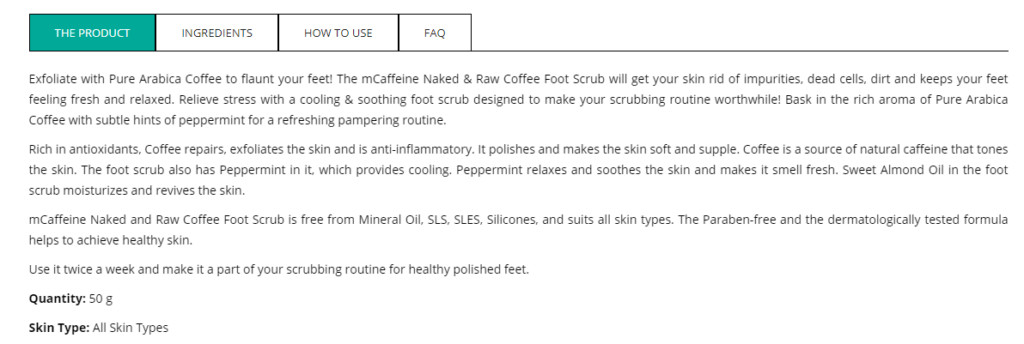
And here’s another:
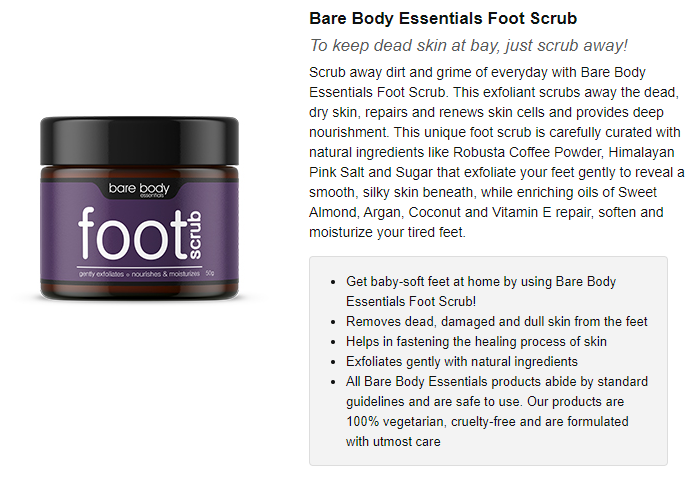
You will instantly see that the first example goes for a more personal vibe. They have also used some major keywords usually associated with such products such as: relieve stress, makes skin soft, exfoliates the skin, anti-inflammatory, paraben-free, etc.
The writing is broken into paragraphs for easy reading. However, one has to scan through a lot of fluff writing to get to the main points.
The second product copy on the other hand aims towards a more stoic approach. A lesser number of keywords have been used, but the major points are in the form of bullets which makes it easy to read and scan.
Let’s take another example where the product description plays an important role. Here’s a product.
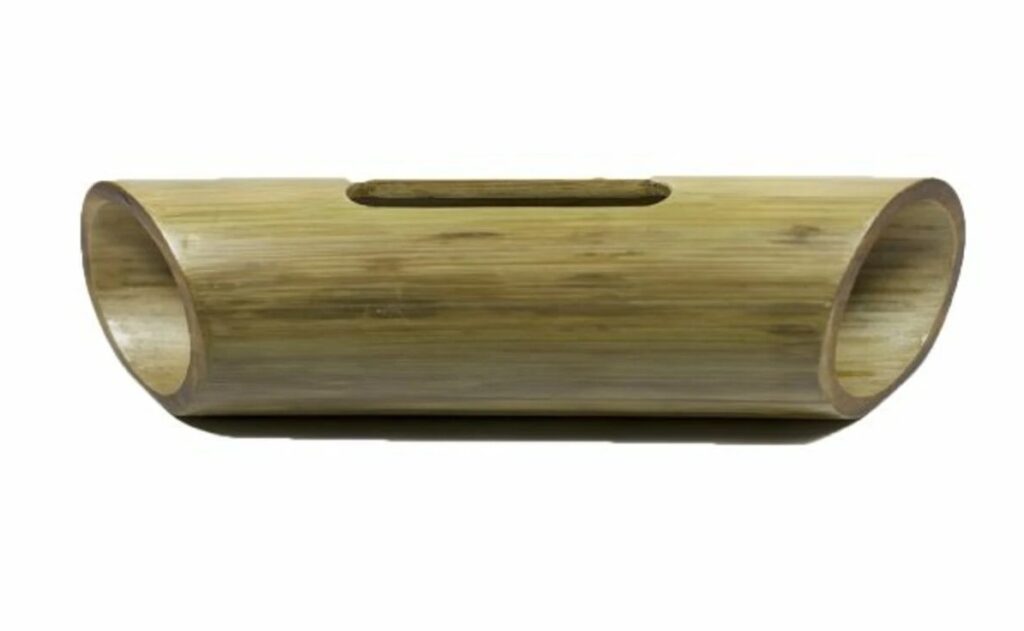
We know the first question that pops into your mind – a piece of bamboo? Now, take a look at the description offered.
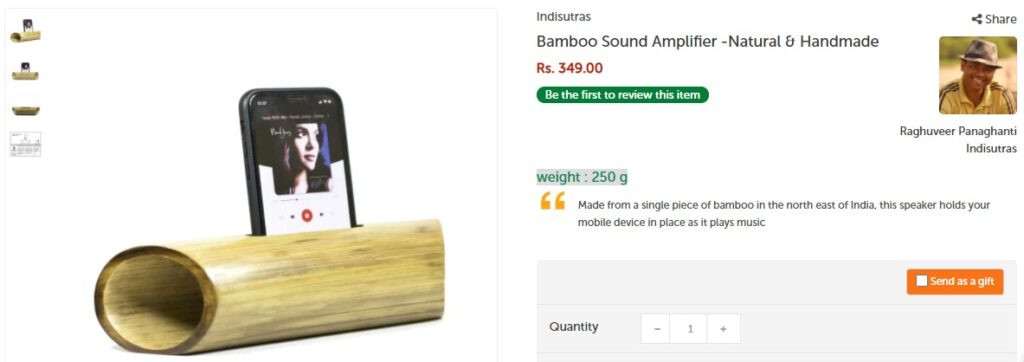
127 characters! That’s all it took to let the user know what the product is and how it functions. In another 82 words, we come to know where the wood is sourced from, what its properties are and how one can use it.
It also removes any possible pain points – like whether the speaker is environmental-friendly or not.

Now, the user can make an informed choice on whether they want to buy this or not. Thus, what a product description does is:
- Describe the product and its features
- Provide information regarding dimensions, usage and durability
- Sell the item to the consumer by drawing their interest
- Remove their doubts regarding any potential pain points
- Answer frequently asked questions and doubts
Depending on the eCommerce merchant you choose to display your product under, you might face a limitation regarding the characters allowed.
Most merchants allow a maximum of 5,000 characters. An ideal description should contain between 300-400 characters – something that can be read within 30 seconds. Within these, you must attract the customer, hold their attention and remove their doubts within the first 50 – 60 characters.
Sounds like a task? It is! So let’s get into some pointers on how you can write amazing product descriptions to improve sales.
Tips For Writing Strong Product Descriptions
1. Creating User Persona
There are currently 7.9 billion people on this planet. And not all of them will want to buy your product! Every product has a “user persona” towards which it is aimed.
A user persona refers to the ideal or average user who will be interested in buying a product. For example, Pepsi describes its target audience as teenagers and young adults between the ages of 15 to 30 years. However, Coca-Cola on the other hand targets users beyond 30 years of age as they appeal to the buyer’s nostalgia.
A single product can also cater to multiple personas. Amazon defines their Prime users into three different personas. These are – the Family Savers, the Natives and the Superusers.
The superusers spend two times as much as regular users and makeup 30% of their revenue. They are also more attracted to luxury goods. These personas are created on the basis of buying motivation, spending capacity, habits and age. So, if we know that a superuser is probably going to see the product copy of a luxury product, we can tailor it accordingly to assuage their needs!
In short, a description must appeal to the demographic it is aimed towards. Here are two examples of wooden plates being sold.
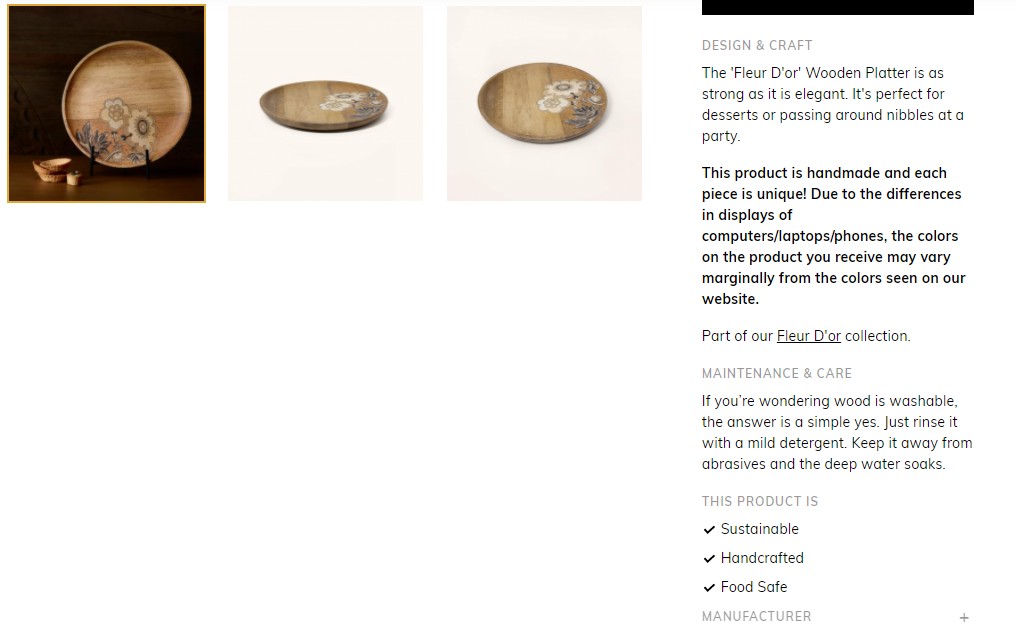
This is a handcrafted piece. The demographic aimed towards includes art connoisseurs and collectors who will value such a piece beyond its inherent physical value. Hence, the product descriptions let them know these main points (in order of importance) –
- Whether the product is unique or not
- Whether the product is handmade or not
- Whether the product is sustainable or not
- Where the wood is sourced from
- Other FAQs
Here, dimensions, probable uses and durability play a secondary role. The proofreader recognizes this.
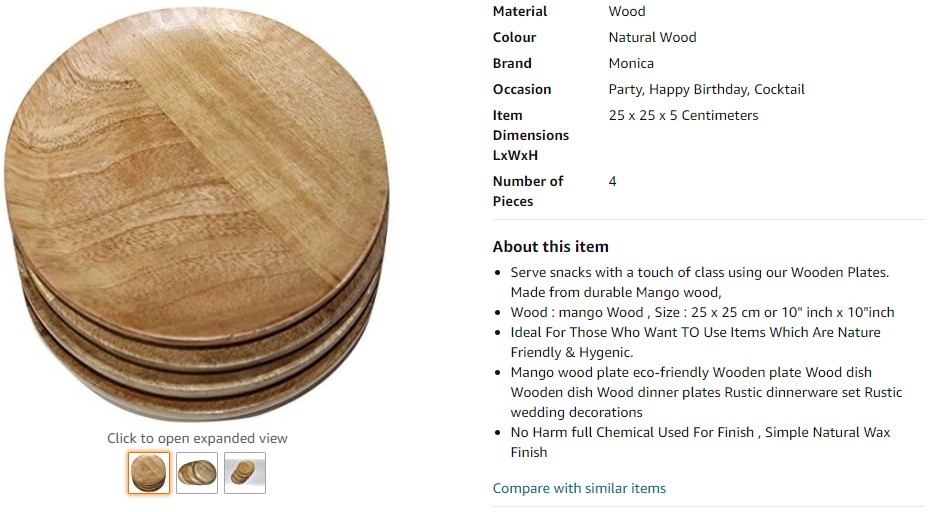
This product on the other hand is aimed towards people simply looking for a wooden plate. Hence, the main things people want to know about are (in order of importance):
- The terms of its use – food, safe, chemical, friendly etc.
- Probably uses
- Sustainability and wood sourcing
- Other FAQs
Here, durability and robustness take the forefront. Hence, the description leads with these. Surely you can see how the sales would have been affected had the product copies been reversed?
There are also multiple tabs on each website for information, dimensions and extended descriptions. People usually see the information tab by default. Hence, you have to segregate what information goes where.

There are many ways to determine your ideal buyer:
- The easiest way is to float a survey. However, surveys have limited reach and filling up forms is not anyone’s favourite way to spend time. Tools like SurveyMonkey can make the forms extremely interactive. You can post these on landing pages, or offer goodies in exchange for form fill-ups (like discount codes or free PDFs).
- The second way is to observe the existing trends. If you already have some products up, use tools like Consumer Barometer or Google Trends to see who buys what. Paid tools also offer other insights like how long do people browse or keep items in carts.
Once you have gathered the information, you can use tools like Up Close & Persona or HubSpot’s “MakeMyPersona” to generate a complete version. You can input the habits and demographics here (survey results) and have a user persona in no time!
2. Using the 5W Formula
The 5W formula refers to the who, what, where, why and why. It is a commonly used formula in both product development and business strategy development.
We know that one has to describe their products by highlighting its benefits. The answers to these questions can better help you quantify those.
Let’s take the example of the A12 Bionic chip and apply the 5W formula here.
Who will use the A12 Bionic chip?
The A12 Bionic chip is available in the iPhone 7 onwards. Hence, it is meant for tech-users looking for smooth functioning, high-end products.
As we have defined the users, we know that they are looking for performance and not necessarily durability or affordability. The next answers can thus highlight the “performance” aspect more.
What are the specifications of the A12 Bionic chip?
Here, we enumerate its features. The demographic includes tech-savvy people, not IT professionals. One does not need to know exactly how it works, rather just that it makes your system work at 2x speed.
Where would the customer use the product?
The product can be incorporated into any Apple device.
When should your customer use this product?
The A12 Bionic chip can be used when someone requires larger cache memory, TDP, GPU power and base frequency.
Why is the product better than other similar products?
Here, one can compare it with the earlier A10 Fusion chip.
Now, we have a complete description of what the A12 Bionic chip does! This forms the core description. Under the extended description, one can enumerate its other features like performance, bandwidth, durability, etc.
3. Storytelling and Brand Imagery
Everyone may not be a reader, but everyone loves a good story. And every big brand that you can think of has a story behind it. Tales abound about how Microsoft started in a small garage, Uber began with its users not finding a taxi and Lance Burstyn started selling chronometer-incorporated watches because his grandfather was stranded on an island.
Not only brands, but even products can tell a story! Here is a description of the Immortality Tea sold by TeemaTeas.

Within the first line, we are transported to another era. We are told that this tea is the stuff of fables. In the next line, we are immediately assured of its modern-world benefits. This is a great example of a compelling description that balances both branding and functionality.
Contrast this with the following example for Goodricke Khaas Assam Tea.
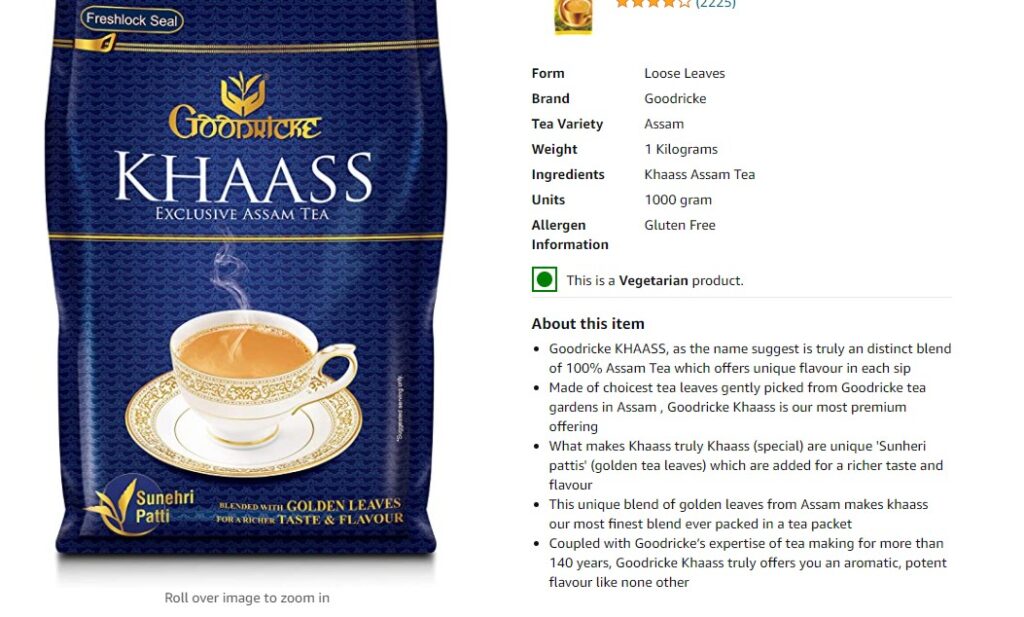
Here, the description focuses only on the brand, and less on the product itself. It also uses more characters and there are frequent repetitions like “is our most premium tea…what makes Khaas truly Khaas”.
Customers might find themselves a bit lost trying to figure out the benefits of such a product. Rather than calling something “superior” or “premium”, one has to enumerate why the product deserves such a tag.
- Features and Benefits
Superlatives are a dangerous ground to be around. Not everything can be the best, most efficient, fattest, smoothest and safest! Rather than claiming, “XYZ offers the smoothest experience”, you can assure the user with a line like, “Enjoy a smooth experience with XYZ.”
Here, we have the term “enjoy”. Thus, we are bringing the user into the sentence as well, rather than mechanically describing what the product is. Nothing assuages a person’s mind than stats. So if needed, include certain technical details – even if it is not something a layman would understand. We can go one step further and combine the two!
Narrate the features, along with transposing on how it will benefit the user. In other words, features and benefits are codependent on one another. Features include how the product works, but benefits include how it helps the user. Here’s an example:
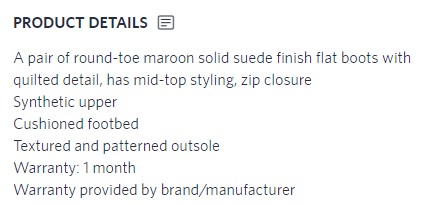
Here, we know the features of the boots. But we do not know the benefits. Will a synthetic upper affect me in any way? Does a textured outsole matter?
Here’s another example:

that’s how long it takes for a user to decide whether they want to stay on a web page or navigate away. So that’s how long you have to convince them that your product is worthwhile!
Not everyone is a reader, so make sure that your description is easily scannable. If the interface allows, use bold or italics to highlight features. If not, then separate your text into small paragraphs and add bullets. Your user might visit the site on their phone, tab or desktop. A four-line paragraph on a desktop might be 12 lines on their phone! So keep every paragraph within 2 to 3 sentences.
Our eyes scan sentences from left to right and then return to the left. A long-distance to traverse means a longer distance to return to. This is why newspapers and magazines are broken into two columns – to prevent eye travel distance. Avoid eye fatigue by using short bullets.
Compare this product description for an earphone:

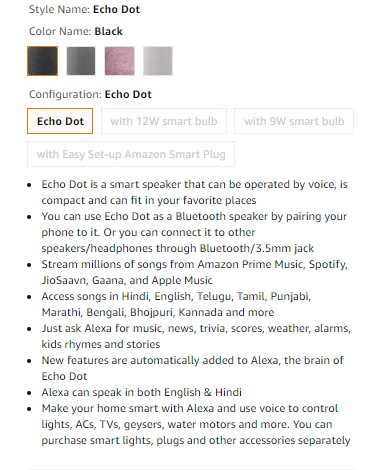
The copy for Amazon Echo allows easy scanning and readability. If a person is not interested in a point, he can simply skip to the next one. But for the pTron earphones, one has to search for the next sentence.
The idea is to feed people maximum information within the minimum time.
- Always Perform SEO
SEO-friendliness has nothing to do with the product but everything to do with user convenience. Search engineers perform rankings mechanically using the available tags. So it’s up to you to find what your target audience is looking for. SEO is one of the main reasons why we need a user persona.
And it’s not always about giving the right heading to your product. Google generally looks for other things as well – such as does it have an optimal description, does it have user reviews, is the language easy to read, and so on.
If you are selling a pair of black leggings, you can search the term on Google to see what they consider as top results.
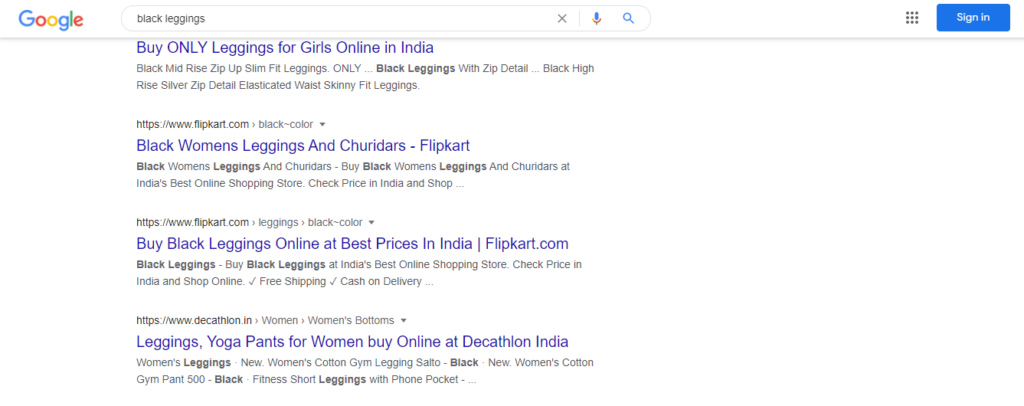
Here, you will be able to identify many other keyword iterations such as Black Women’s Leggings, Buy Black Leggings India, Women’s Leggings, Skinny Combed Cotton Skinny Leggings and so on. Generally, colour (black), the main feature (stretchable), product name (leggings) and some cost ideas (low-cost) can be used to create headings.
Hence, you can create iterations like:
- Buy Low-cost Stretchable Black Women’s Leggings in India
- High-end Breathable Black Leggings For Women
However, this is a rudimentary method at best. To better understand keywords, you will need to refer to SEO tools like Google Keywords, AHRefs or SmallSEOTools.
Conclusion – Always Test!
Finally, it’s all about user testing. Use a survey group to see the effect of your product description. Use A/B Testing tools to see what users respond to.
We live in a fast-paced world. At its peak, Amazon was selling an average of 306 items every second. Special deals like Back Friday Sales and Cyber Monday Sales saw the total number rise to as high as 27 million!
The stats are not so good for Shopify users. The average account made only 72 USD and only 5% of the total stores are believed to be successful.
What can help a product stand out is its description. Brands that stand out often experimented with various types of branding, graphics, and slowly built a reputation. It is a matter of time, patience and trial.